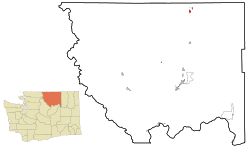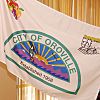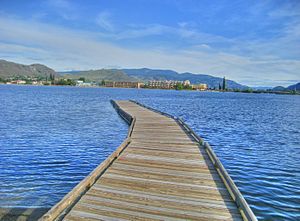Oroville, Washington facts for kids
Quick facts for kids
Oroville
|
||
|---|---|---|

View of Oroville, Washington and Osoyoos Lake, looking north towards Canada.
|
||
|
||

Location of Oroville in
Okanogan County, Washington |
||
| Country | United States | |
| State | Washington | |
| County | Okanogan | |
| Established | January 1, 1892 | |
| Incorporated | August 7, 1908 | |
| Government | ||
| • Type | Mayor–council | |
| Area | ||
| • Total | 1.85 sq mi (4.78 km2) | |
| • Land | 1.69 sq mi (4.38 km2) | |
| • Water | 0.16 sq mi (0.40 km2) | |
| Elevation | 938 ft (286 m) | |
| Population
(2020)
|
||
| • Total | 1,795 | |
| • Density | 970.3/sq mi (375.5/km2) | |
| Time zone | UTC-8 (PST) | |
| • Summer (DST) | UTC-7 (PDT) | |
| ZIP codes |
98844
|
|
| Area code(s) | 509 | |
| FIPS code | 53-51970 | |
| GNIS feature ID | 1524077 | |
| Website | City of Oroville | |
Oroville is a city located in the northern bulk of the Okanogan Highlands in north-central Washington, United States. Oroville is a member municipality of Okanogan County, Washington, situated between Omak and Penticton. The population was 1,795 at the 2020 census.
History
Oroville was first settled by European settlers in the late 1850s and known as 'rag town.' The settlement was named Oro, after the Spanish word for gold, in 1892 after the surrounding gold mines and in an attempt to attract prospectors and merchants. The Post Office objected to the name "Oro" because a town was already named "Oso" in Washington, so the name was changed to Oroville, in 1909. Oroville was a stop along the Spokane Falls and Northern Railway line from British Columbia to Spokane, via Molson and Chesaw. In 1914 a third branch south to Wenatchee was constructed to avoid the steep inclines on the original Spokane track.
Passenger train service to Oroville was operated by the Great Northern Railway until July 14, 1953, with freight operations continuing later.
Oroville started to become a tourist location in the mid-2000s, large condo developments were proposed. After peaking in 2005–07, the city’s economy has suffered since the Great Recession of 2008. Oroville is home to the Dorothy Scott Airport, an international municipal airport with U.S. Customs check, located two miles outside of the town center. The airport opened in August 1937.
Geography
Oroville is located 4 miles (6.4 km) south of the Canada–US border, and features an official crossing into Osoyoos, British Columbia. It is located at the south end of Osoyoos Lake, which empties into the Okanogan River on the east side of the town; the town is bound to the west by the Similkameen River. U.S. Route 97 runs through Oroville.
According to the United States Census Bureau, the city has a total area of 1.68 square miles (4.35 km2), of which, 1.64 square miles (4.25 km2) is land and 0.04 square miles (0.10 km2) is water.
Climate
Oroville lies in a climatic region that is typified by large seasonal temperature differences, with warm to hot summers and moderately cold winters. According to the Köppen climate classification system, Oroville has a humid continental climate, Dfb on climate maps.
Economy
Most of the economy of Oroville and the surrounding areas is based on agriculture. Numerous orchards and a few grape vineyards are within the town limits. During Oroville's heyday as a mining town, many saloons, restaurants, shops, and a drive-in movie theater were there. Today, the town's economy is depressed with a nearly 30% poverty rate and a median household income of only $22,000. Recently, three vacation cottage developments have been built, two east of Lake Osoyoos, Sandalia, and the Veranda Beach Resort, and one just north of downtown, Sonora Shores.
The city is home to a weekly newspaper, the Okanogan Valley Gazette-Tribune, established in 1905 as the Oroville Weekly Gazette. Okanogan Living, a monthly lifestyle magazine based in Tonasket, also serves the region.
Oroville is the northern terminus of the Cascade and Columbia River Railroad, a short line railroad owned by Genesee & Wyoming.
Demographics
| Historical population | |||
|---|---|---|---|
| Census | Pop. | %± | |
| 1910 | 495 | — | |
| 1920 | 1,013 | 104.6% | |
| 1930 | 800 | −21.0% | |
| 1940 | 1,206 | 50.8% | |
| 1950 | 1,500 | 24.4% | |
| 1960 | 1,437 | −4.2% | |
| 1970 | 1,555 | 8.2% | |
| 1980 | 1,483 | −4.6% | |
| 1990 | 1,505 | 1.5% | |
| 2000 | 1,653 | 9.8% | |
| 2010 | 1,686 | 2.0% | |
| 2020 | 1,795 | 6.5% | |
| U.S. Decennial Census 2020 Census |
|||
2010 census
At the 2010 census there were 1,686 people in 698 households, including 434 families, in the city. The population density was 1,028.0 inhabitants per square mile (396.9/km2). There were 797 housing units at an average density of 486.0 per square mile (187.6/km2). The racial makeup of the city was 78.8% White, 0.8% African American, 2.4% Native American, 1.1% Asian, 0.1% Pacific Islander, 12.7% from other races, and 4.2% from two or more races. Hispanic or Latino of any race were 21.4%.
Of the 698 households 33.1% had children under the age of 18 living with them, 45.6% were married couples living together, 10.7% had a female householder with no husband present, 5.9% had a male householder with no wife present, and 37.8% were non-families. 32.1% of households were one person and 16.3% were one person aged 65 or older. The average household size was 2.41 and the average family size was 3.03.
The median age was 39.4 years. 26.2% of residents were under the age of 18; 7.5% were between the ages of 18 and 24; 23.3% were from 25 to 44; 26.2% were from 45 to 64; and 16.7% were 65 or older. The gender makeup of the city was 49.2% male and 50.8% female.
See also
 In Spanish: Oroville (Washington) para niños
In Spanish: Oroville (Washington) para niños




